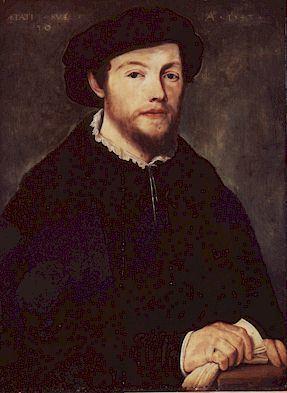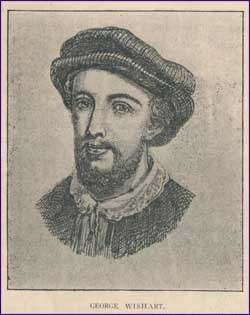Name George Wishart | ||
 | ||
Education | ||
George wishart burned at the stake for christ
George Wishart (c. 1513 – 1 March 1546) was a Scottish religious reformer and Protestant martyr.
Contents
- George wishart burned at the stake for christ
- George Wishart Scotlands Forgotten Forerunner Episode 32 Lineage
- Life
- References

George Wishart: Scotland's Forgotten Forerunner | Episode 32 | Lineage
Life

He belonged to a younger branch of the Wisharts of Pitarrow near Fordoun, Kincardineshire. He may have graduated M.A., probably at King's College, Aberdeen, and was certainly a student at the University of Leuven, from which he graduated in 1531. He taught the New Testament in Greek as schoolmaster at Montrose in Angus, until investigated for heresy by the Bishop of Brechin in 1538. He fled to England, where a similar charge was brought against him at Bristol in the following year by Thomas Cromwell. Under examination by Archbishop Thomas Cranmer he recanted some utterances. In 1539 or 1540 he may have visited Germany and Switzerland, but by 1542 he had entered Corpus Christi College, Cambridge, where he studied and taught.

In 1543 he returned to Scotland, in the train of a Scottish embassy which had come to London to consider the treaty of marriage between Prince Edward (later Edward VI of England) and the infant Mary, Queen of Scots. He returned to Montrose, where again he taught Scripture.

He may have been the "Scottish man called Wishart" acting as a messenger to England for Alexander Crichton of Brunstane in a 1544 plot against Cardinal David Beaton. Some historians such as Alphons Bellesheim and Richard Watson Dixon have accepted this identification; others are sceptical. Other possibilities include a George Wishart, Baillie of Dundee, who allied himself with Beaton's murderers; and Sir John Wishart (d. 1576), afterwards a Scottish judge.
His career as an itinerant preacher began in 1544, from when he traveled Scotland from east to west. The story has been told by his disciple John Knox. He went from place to place, in danger of his life, denouncing the errors of the Papacy and the abuses in the churches of Montrose, Dundee (where he escaped an attempt on his life), Ayr, Perth, Edinburgh, Leith, Haddington (where Knox accompanied him) and elsewhere.
At Ormiston in East Lothian, in January 1546, he was seized by Lord Bothwell on the orders of Cardinal Beaton, taken to Elphinstone Castle, and transferred by order of the privy council to Edinburgh castle on 19 January 1546. Thence he was handed over to Beaton, who had a "show trial", with John Lauder prosecuting Wishart. He was hanged on a gibbet and his body burned at St Andrews on 1 March 1546. Foxe and Knox attribute to him a prophecy of the death of the Cardinal, who was assassinated on 29 May following, partly in revenge for Wishart's death.
Wishart's preaching in 1544–45 helped popularize the teachings of Calvin and Zwingli in Scotland. He translated into English the first Helvetic Confession of Faith in 1536. At his trial he refused to accept that confession was a sacrament, denied free will, recognized the priesthood of all believing Christians, and rejected the notion that the infinite God could be "comprehended in one place" between "the priest's hands". He proclaimed that the true Church was where the Word of God was faithfully preached and the two dominical sacraments rightly administered.
The Martyrs Memorial at St Andrews was erected to the honour of George Wishart, Patrick Hamilton, and other martyrs of the Reformation era. There is a house at Saint Kentigern College in Auckland, New Zealand, named after him.
Dundee's East Port (also known as Cowgate Port), the remains of a gateway in the town's walls, is known as the Wishart Arch. The Arch is the only surviving portion of the town's walls, and probably survived owing to a story that George Wishart preached from it in 1544 to plague victims. However this story has been described as 'probably-mythical' and the structure is thought to have been built around 1590, long after Wishart's death.
